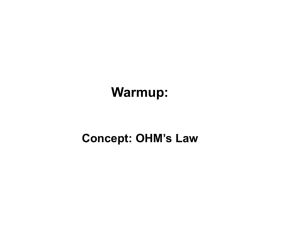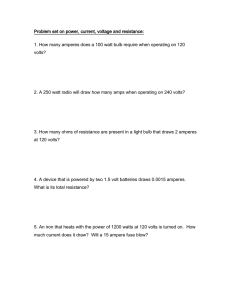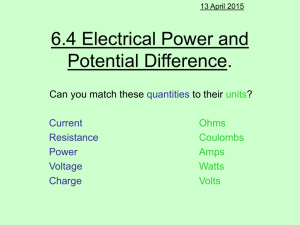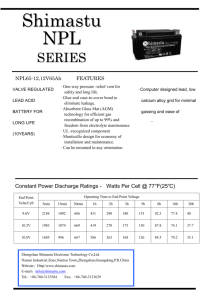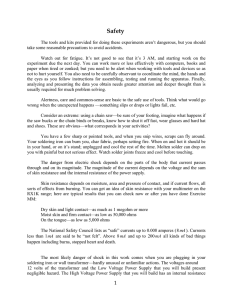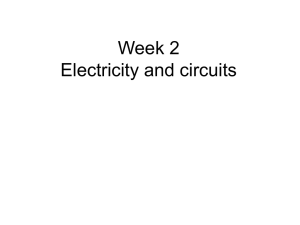T5D01 (B) What formula is used to calculate current in a circuit? A
advertisement
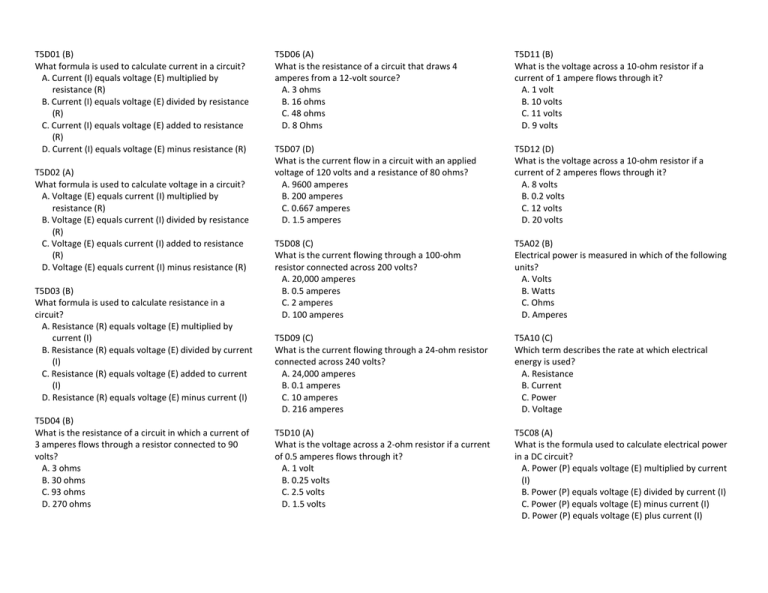
T5D01 (B) What formula is used to calculate current in a circuit? A. Current (I) equals voltage (E) multiplied by resistance (R) B. Current (I) equals voltage (E) divided by resistance (R) C. Current (I) equals voltage (E) added to resistance (R) D. Current (I) equals voltage (E) minus resistance (R) T5D02 (A) What formula is used to calculate voltage in a circuit? A. Voltage (E) equals current (I) multiplied by resistance (R) B. Voltage (E) equals current (I) divided by resistance (R) C. Voltage (E) equals current (I) added to resistance (R) D. Voltage (E) equals current (I) minus resistance (R) T5D03 (B) What formula is used to calculate resistance in a circuit? A. Resistance (R) equals voltage (E) multiplied by current (I) B. Resistance (R) equals voltage (E) divided by current (I) C. Resistance (R) equals voltage (E) added to current (I) D. Resistance (R) equals voltage (E) minus current (I) T5D04 (B) What is the resistance of a circuit in which a current of 3 amperes flows through a resistor connected to 90 volts? A. 3 ohms B. 30 ohms C. 93 ohms D. 270 ohms T5D06 (A) What is the resistance of a circuit that draws 4 amperes from a 12-volt source? A. 3 ohms B. 16 ohms C. 48 ohms D. 8 Ohms T5D11 (B) What is the voltage across a 10-ohm resistor if a current of 1 ampere flows through it? A. 1 volt B. 10 volts C. 11 volts D. 9 volts T5D07 (D) What is the current flow in a circuit with an applied voltage of 120 volts and a resistance of 80 ohms? A. 9600 amperes B. 200 amperes C. 0.667 amperes D. 1.5 amperes T5D12 (D) What is the voltage across a 10-ohm resistor if a current of 2 amperes flows through it? A. 8 volts B. 0.2 volts C. 12 volts D. 20 volts T5D08 (C) What is the current flowing through a 100-ohm resistor connected across 200 volts? A. 20,000 amperes B. 0.5 amperes C. 2 amperes D. 100 amperes T5A02 (B) Electrical power is measured in which of the following units? A. Volts B. Watts C. Ohms D. Amperes T5D09 (C) What is the current flowing through a 24-ohm resistor connected across 240 volts? A. 24,000 amperes B. 0.1 amperes C. 10 amperes D. 216 amperes T5A10 (C) Which term describes the rate at which electrical energy is used? A. Resistance B. Current C. Power D. Voltage T5D10 (A) What is the voltage across a 2-ohm resistor if a current of 0.5 amperes flows through it? A. 1 volt B. 0.25 volts C. 2.5 volts D. 1.5 volts T5C08 (A) What is the formula used to calculate electrical power in a DC circuit? A. Power (P) equals voltage (E) multiplied by current (I) B. Power (P) equals voltage (E) divided by current (I) C. Power (P) equals voltage (E) minus current (I) D. Power (P) equals voltage (E) plus current (I) T5C09 (A) How much power is being used in a circuit when the applied voltage is 13.8 volts DC and the current is 10 amperes? A. 138 watts B. 0.7 watts C. 23.8 watts D. 3.8 watts T5B10 (C) What is the approximate amount of change, measured in decibels (dB), of a power decrease from 12 watts to 3 watts? A. 1 dB B. 3 dB C. 6 dB D. 9 dB T5C10 (B) How much power is being used in a circuit when the applied voltage is 12 volts DC and the current is 2.5 amperes? A. 4.8 watts B. 30 watts C. 14.5 watts D. 0.208 watts T5B11 (A) What is the approximate amount of change, measured in decibels (dB), of a power increase from 20 watts to 200 watts? A. 10 dB B. 12 dB C. 18 dB D. 28 dB T5C11 (B) How many amperes are flowing in a circuit when the applied voltage is 12 volts DC and the load is 120 watts? A. 0.1 amperes B. 10 amperes C. 12 amperes D. 132 amperes T5B09 (B) What is the approximate amount of change, measured in decibels (dB), of a power increase from 5 watts to 10 watts? A. 2 dB B. 3 dB C. 5 dB D. 10 dB
